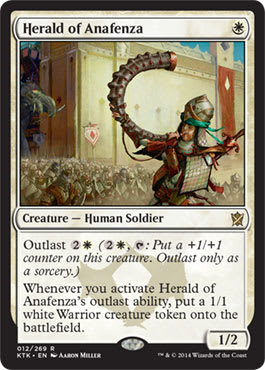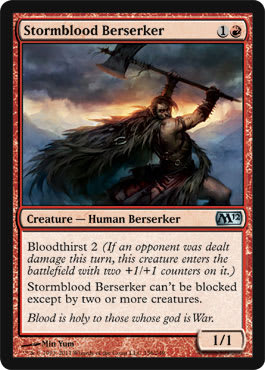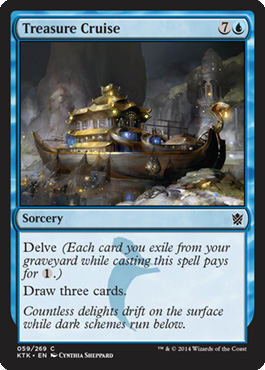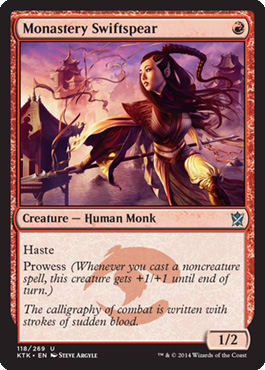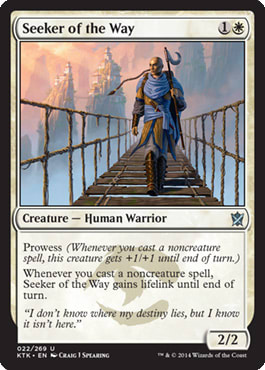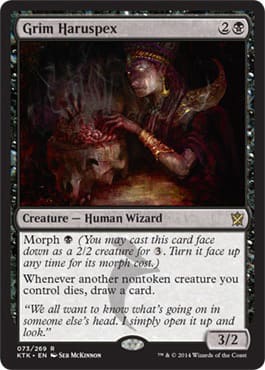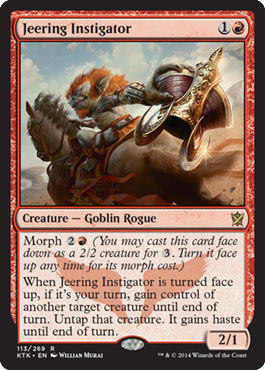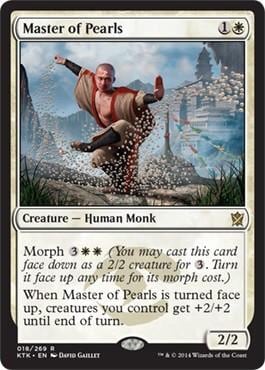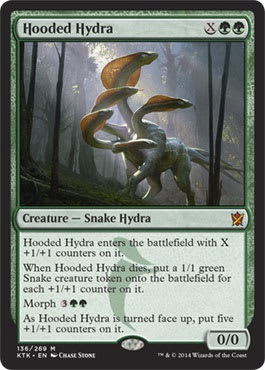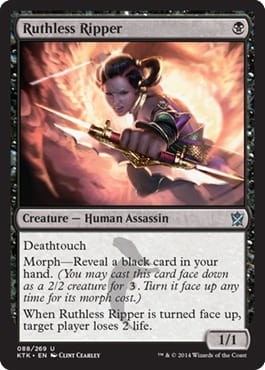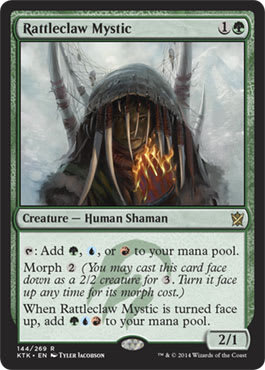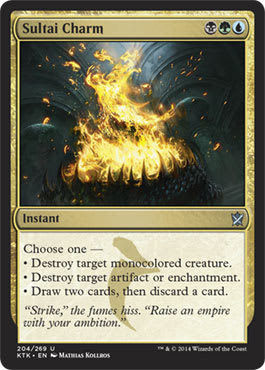In this review, I'll be focusing on the set's mechanics and how they and other cards manifest for Cube.
Outlast
The idea is that it gives creature a way to power up in the later stages of the game. We've seen this with cards like Kargan Dragonlord, but outlast's +1/+1 counter theme is rendered toothless due to the low count of cards that care. Let's look at the number of interactions with it in the Cubetutor Average 450 List:
- Ajani, Caller of the Pride
- Ajani Goldmane
- Geralf's Messenger
- Stromkirk Noble
- Gore-House Chainwalker
- Stormblood Berserker
- Experiment One
- Scavenging Ooze
- Strangleroot Geist
- Polukranos, World Eater
- Avenger of Zendikar
- Rakdos Cackler
- Falkenrath Aristocrat
- Olivia Voldaren
Even considering cards like Archangel of Thune, Kalonian Hydra, Curse of Predation, and Ajani, Mentor of Heroes that could make a four-hundred-fifty-card Cube, interactions are still limited.
This leaves looking at the ability at its own. Being at sorcery speed, requiring the use of mana, and tapping the creature is the ultimate low, but there's an argument that those creatures aren't really going to be doing anything anyway if brick-walled and if the rate of doing so isn't prohibitive. Look at the two better outlast cards:
Herald of Anafenza had the best chance as an early drop with a way to generate value in the late game by making an army of guys and becoming a sizable threat, but its weak 1/2 stats were a factor against it, and its high activation cost made it unwieldy for aggressive decks. Ainok Bond-Kin's mediocre stats, while being serviceable, didn't combine well with its still-relatively-high outlast cost, relegating it to a filler, 2-mana, white card.
Raid
Despite the abundance of cheap removal in the format, raid is a solid mechanic for Cube attacking decks. Think back to Stormblood Berserker:
It got bloodthirsty from an attacking creature dealing damage to an opponent much more often than from using direct damage, and raid works well even with chump-attacking. The fear of having a creature unable to be raided is mostly unfounded, so it's almost always considered a constant for evaluation.
Because of this, several fit very well into Cube attacking decks due to their high efficiency—Bloodsoaked Champion is the best 1-drop in Cube, as it's very difficult to stop and works well with sacrifice cards like Smokestack and Braids, Cabal Minion, and Mardu Skullhunter works well as a riff on Ravenous Rats that attack for 2 while disrupting, a rate that hasn't been seen in Cube outside of Tidehollow Sculler. Others, such as Wingmate Roc, work decently as a aggro curve-toppers, representing 6 evasive power for 5 mana, but unlike the other raid cards, it's more at home in midrange decks that trigger raid from a mana Elf or a value 2/2. Howl of the Horde ended up suffering the same fate as other Forks due to inconsistencies in having the right combination of them with something to copy—due to the absurdly high ceiling, though, it made it a difficult fit for Cube.
Ferocious
Even though we think of midrange and control decks as defined by their 4-or-more-power creatures, most don't play enough to reliably trigger ferocious. Because of this, ferocious cards need to be good enough with this in mind. Unfortunately, none are.
Delve
For Cube, the main factor is “being paid” for playing them. Think back to decks centered around Cruel Ultimatum and Sphinx's Revelation; these decks centered around a plan of playing tit for tat and taking advantage of that by casting a big spell to go over the top, using the momentum gained through the spell to win the game. Because of this, cards like Tombstalker have had some success by letting their casters make a cheap, big threat, but sometimes, it just wasn't enough. The best delve cards from Khans of Tarkir are the draw spells:
These don't work like typical Cube draw spells because they can't just be cast after playing a mana rock, but instead, they rely on reaching the later stages of the game and being able to push through card advantage; usually, I've found Dig Through Time gets delved for 4 or 5, which is an astounding cost for instant-speed Ancestral Memories—and I’ve seen similar results for Treasure Cruise.
What of other cards, such as Murderous Cut? The Cut doesn’t make the cut due to the payoff being pretty marginal compared to the times when it’s unable to be delved (casting it at ![]()
![]() is merely an upgrade to Go for the Throat, and anything over that is abysmal), and Empty the Pits, although better than it looks, ends up not making the cut in many Cubes due to the prohibitive
is merely an upgrade to Go for the Throat, and anything over that is abysmal), and Empty the Pits, although better than it looks, ends up not making the cut in many Cubes due to the prohibitive ![]()
![]()
![]()
![]() cost.
cost.
Prowess
These prowess cards work similarly to the Searing cards in aggro decks by providing momentum while being proactive, and although it doesn't trigger off creatures, there are a surprisingly high number of noncreature creatures (Lingering Souls) and supplemental cards such as Equipment, Planeswalkers, and removal. They aren't near-always active the way Steppe Lynx is, but I found that they triggered enough to have them perform admirably in decks that can consistently trigger them, which is easier to do than one would think. Seeker of the Way is the better of the two as a solid riff on Knight of Meadowgrain for attacking through 2/2s, racing, and not costing ![]()
![]() , and like the Knight, it works well in slower white decks but not is embarrassing in aggressive strategies.
, and like the Knight, it works well in slower white decks but not is embarrassing in aggressive strategies.
Non-Mechanic Cards
Clever Impersonator and Sarkhan, the Dragonspeaker lead the pack for pure flexibility, the former being able to copy creatures at a decent base rate but having the flexibility to copy just about anything else that's relevant, and the latter for acting as a split between a Stormbreath Dragon and Flametongue Kavu that works incredibly well in all red decks (even as a singleton curve-topper in aggro).
End Hostilities is a decent second 5-mana Wrath if necessary as a secondary to Rout, but it’s better than Winds of Rath or Hallowed Burial but better than most of the awkward 6-mana Wraths. Goblinslide, Hordeling Outburst, and Valley Dasher are decent archetype-supporting cards but fall a bit short in overall power for most smaller Cubes.
Morph
Sam Stoddard wrote an article on morph describing how one can't eat another for less than 5 mana—that was implemented to avoid combat awkwardness. Where do morphs go from here? Gone are the days of big beaters like Exalted Angel that give a one-turn window to kill it or take a lot of damage, as this set's morphs are more utility in nature. Most morphs in Cube follow this rule anyway: of being utility creatures over brawlers, with Exalted Angel being the lone exception. The current issue with morphs in Cube is that there's only really one good one per color, and the next ones down were big steps down. How do Khans of Tarkir's morphs fare?
Grim Haruspex, Jeering Instigator, and Master of Pearls disappointed as morphs with a trick, the latter two for being too expensive for the ability (even if it came with a free creature) and Haruspex because it, instead of being a Wrath-wrecking and sacrifice-enabling machine, usually just died while being a mediocre 2/2 or 3/2 creature.
Ashcloud Phoenix and Hooded Hydra are the set's Exalted Angel–style morph brawlers with resistance to removal, both performing better than expected with their hard-cast modes being their primary modes, but with their morph abilities being solid backups (more so with Hooded Hydra). 4-drops in red are hard sells when they don't end the game soon after due to the color's aggressive nature, but even if Ashcloud Phoenix just comes back as a 2/2, it usually has time to morph up again in slower red decks wherein the Phoenix would shine.
Temur Charger and Ruthless Ripper are solid riffs on morphs, as they're atypical because of having no morph mana costs while still having decent bodies for the cost (essentially a 2/2 deathtouch for 3 or a 3/1 for ![]()
![]() that can be a combat trick). The problem with cards like Gathan Raiders and Zombie Cutthroat was that even if they were free and in a Cube, they typically weren't good enough to make most decks, limiting their impact, whereas these new free morphs have performed better.
that can be a combat trick). The problem with cards like Gathan Raiders and Zombie Cutthroat was that even if they were free and in a Cube, they typically weren't good enough to make most decks, limiting their impact, whereas these new free morphs have performed better.
Last, Rattleclaw Mystic has served well as a supplemental mana elf with some burst factor that works in Simic and Gruul decks that played decently well in mono-green, Selesnya, and Golgari, but it’s a harder sell in smaller Cubes wherein it's directly competing with Devoted Druid and Wall of Roots.
Oddly, blue, the color with the lowest creature count, didn't receive a morph worth caring about, and Clever Impersonator will probably kick out Vesuvan Shapeshifter, so the dream of having two morphs per color will have to wait for the next set.
Dual and Tri-Color Cards
Cards such as Utter End, Mindswipe, and Rakshasa Deathdealer suffer the fate of losing out in incredibly competitive color pairs. Sorin, Solemn Visitor is better than it looks as an Anthem, but it pales to Sorin, Lord of Innistrad and Gerrard's Verdict, and Sagu Mauler, which is a nice, big brawler, is best cast at 6, which makes up for its nonflying status compared to Simic Sky Swallower by being cheaper, as it has morph and hexproof, but still finds it hard to crack through extremely competitive two-color pairs. Multicolored cards are limited because of the fac that they limit themselves in terms of what decks can play them—think of how surprisingly often cards like Sorin, Lord of Innistrad and Trygon Predator can ride the pine because no one is in that archetype, a problem that can be compounded in smaller deck pods. That factor grows much worse with tri-color cards.
Their inclusions in your Cube come down to a general include-them-if-you-want decision. Cubes have run the gamut from including the full cycle of ten, when Intet, the Dreamer and Guided Passage were the sole Temurs, to just running cards like Wild Nacatl, Nicol Bolas, Planeswalker, and Sphinx of the Steel Wind post-Conflux. The standouts are so because of their raw efficiency: Siege Rhino, Butcher of the Horde, and Savage Knuckleblade are standouts in their wedges because of the high efficiency for their mana costs.
Mantis Rider compares favorably versus Lightning Angel; it loses a 4th toughness at the benefit of a 3rd mana, which is worse against Lightning Bolts and 3/3 Beasts, and we tend to identify red's identity with Lightning Bolts. When looking back at the Cubetutor 450 Average List:
As noted earlier, some cards, such as Lightning Strike and Fire Imp, probably could or should see play in a Cube that size, but still, out of fifty-nine red cards (including Shrine of Burning Rage), that isn't really enough to define the color, and despite seeing more 3-power cards like War-Name Aspirant, 3 power isn't a defining bar either. Even though tri-color cards are hardly ever cast on curve, the value of being able to do other things with the extra mana outweighs the extra toughness.
Sultai Charm works well due to its high flexibility with its modes all being solid for the cost, whereas a card like Sidisi, Brood Tyrant requires too much setup for Cube to be worth using.
Please note the tri-color limitation factor, and even if the cards are objectively powerful, note that because of their limitations, their raw power may make appear that they'll be included in more decks than they will actually be. I hope you've enjoyed this rundown of Khans of Tarkir!
@UsmanTheRad on Twitter
My blog featuring my Cube lists
Cube podcast that Anthony Avitollo and I co-host














